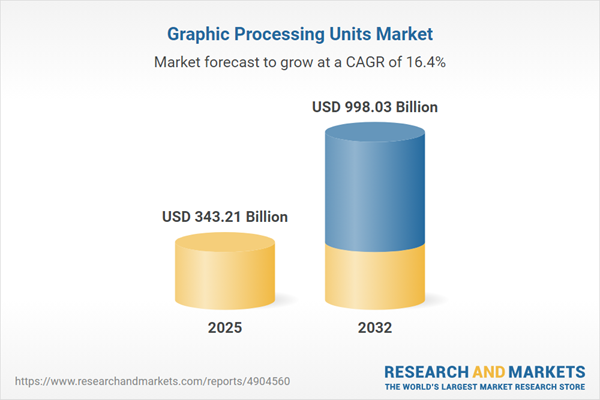Speak directly to the analyst to clarify any post sales queries you may have.
The graphics processing units market is redefining how organizations approach modern IT initiatives, making GPUs central to analytics, business transformation, and technology deployment. Senior leaders are embedding this technology to enhance performance, streamline compliance, and achieve sustainable growth.
Market Snapshot: Graphics Processing Units Market Size & Growth Outlook
The global graphics processing units market reached USD 296.08 billion in 2024 and is poised for continued advancement, with projections indicating growth to USD 343.21 billion by 2025. By 2032, supported by a compound annual growth rate of 16.40%, the market is anticipated to reach USD 998.03 billion. This robust trajectory reflects increasing investment in high-performance computing, widespread adoption of AI-enabled applications, and the modernization of both legacy and active IT infrastructure. As organizations respond to critical digital imperatives, the graphics processing units market is firmly positioned as a strategic enabler for future-ready enterprise technology.
Scope & Segmentation Analysis of the Graphics Processing Units Market
Access to clear market segmentation enables technology executives to better align resource planning and IT deployments with operational requirements. Understanding the core segments of this sector ensures agile responses to evolving regulations and the practical implementation of advanced GPU solutions across industries.
- Product Types: Discrete GPUs are chosen for high-end analytics and specialized workflows, delivering intensive computational capabilities, while integrated GPUs offer dependable and cost-effective performance for standard enterprise tasks.
- Deployment Models: Enterprises benefit from cloud, on-premise, edge, and dedicated server options, facilitating optimal workload deployment, data governance, and regulatory compliance across various environments.
- Architectures: Organizations select among platforms such as AMD RDNA, Intel Xe, and NVIDIA to power analytics, visualization, and sector-driven innovation, ensuring alignment with specific workload demands.
- Applications: GPU solutions form the basis for AI-enhanced analytics, digital content creation, support for autonomous operations, simulation projects, blockchain and cryptocurrency activities, and fully immersive enterprise experiences.
- End Users: Core industries utilizing GPU technology include manufacturing, financial services, digital media, and scientific research, where high-throughput and scalable compute resources shape competitive strategies.
- Key Regions: The Americas, Europe, Middle East and Africa, and Asia-Pacific each display distinct adoption trends, influenced by infrastructure maturity and regulatory environments that drive procurement and rollout decisions.
- Leading Companies: Market presence is established by Intel Corporation, NVIDIA Corporation, Advanced Micro Devices, Qualcomm Incorporated, MediaTek Inc., Samsung Electronics, Apple Inc., Broadcom Inc., UNISOC Communications, and HiSilicon Technologies, providing organizations with extensive solution options and lasting supplier relationships.
Key Takeaways for Senior Decision-Makers
- Cloud-based strategies using GPU deployments offer unprecedented flexibility, enabling enterprises to adapt infrastructure in line with changing workloads and regulatory mandates while optimizing budget allocation.
- Implementation of centralized management platforms for GPUs streamlines operational oversight, helping IT teams maximize resource efficiency and reduce administrative complexity across diverse environments.
- The programmability of modern GPU platforms enables creation of digital twins, advanced visualization tools, and scenario-driven simulations, empowering organizations to identify risks and opportunities proactively.
- Incorporating energy-efficient GPUs into wider sustainability initiatives assists with emission tracking and supports responsible technology utilization, aligning with evolving environmental expectations.
- Strategic partnerships with leading GPU vendors promote long-term operational resilience, future-proofing organizations against technology disruption and supporting continuous business transformation.
Tariff Impact on GPU Supply Chain Dynamics
Forthcoming US tariffs present new challenges for the GPU supply chain. Manufacturers are mitigating risk by diversifying production footprints and expanding sourcing networks across multiple vendors and geographies. These adaptive measures ensure organizations retain secure access to critical technology and support ongoing investment and procurement planning, even as trade policies shift.
Methodology & Data Sources
This analysis synthesizes executive-level procurement feedback, independent technical reports, and proprietary research. Each data point is rigorously validated to deliver senior decision-makers with dependable intelligence for managing GPU investments.
Why This Report Matters
- Enables technology leaders to synchronize IT initiatives with current industry standards, regulatory changes, and operational priorities to enhance organizational agility.
- Clarifies supply chain and procurement risk variables, supporting more informed vendor selection, contract negotiation, and resource allocation across deployment environments.
- Strengthens organizational resilience and readiness for evolving technology trends and business requirements with actionable market intelligence.
Conclusion
Senior executives gain targeted insights to drive innovation, modernize IT, and maintain agility as industry and regulatory environments evolve. This supports confident investment and future-oriented planning in the graphics processing units market.
Additional Product Information:
- Purchase of this report includes 1 year online access with quarterly updates.
- This report can be updated on request. Please contact our Customer Experience team using the Ask a Question widget on our website.
Table of Contents
3. Executive Summary
4. Market Overview
7. Cumulative Impact of Artificial Intelligence 2025
Companies Mentioned
The companies profiled in this Graphic Processing Units market report include:- Intel Corporation
- Qualcomm Incorporated
- Advanced Micro Devices, Inc.
- NVIDIA Corporation
- MediaTek Inc.
- Samsung Electronics Co., Ltd.
- Apple Inc.
- Broadcom Inc.
- UNISOC Communications Inc.
- HiSilicon Technologies Co., Ltd.
Table Information
| Report Attribute | Details |
|---|---|
| No. of Pages | 185 |
| Published | October 2025 |
| Forecast Period | 2025 - 2032 |
| Estimated Market Value ( USD | $ 343.21 Billion |
| Forecasted Market Value ( USD | $ 998.03 Billion |
| Compound Annual Growth Rate | 16.4% |
| Regions Covered | Global |
| No. of Companies Mentioned | 11 |









